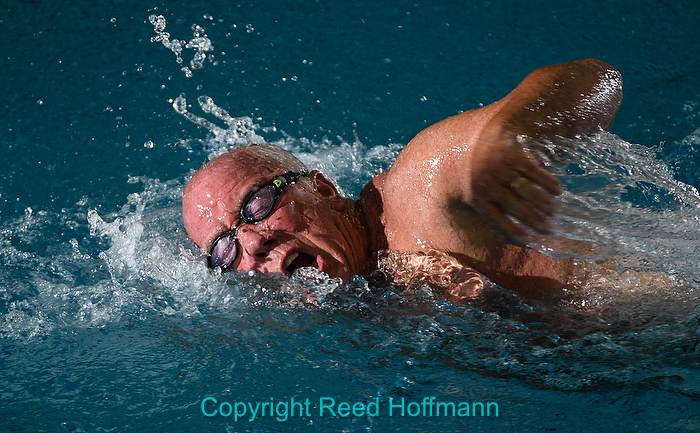Swimming is a challenging sport to shoot. It’s usually indoors in poor light, faces are hidden much of the time, color can be challenging and just getting a good action shot is difficult. My answer? Light it with flash.
In early June I drove to Edmond, Oklahoma to shoot the Endeavor Games for Disabled Sports USA. I’ve been doing photography for them for about ten years now, and this event would let me create images from a wide range of sports in just a few days. DSUSA wants those photos for their magazine and website, and to promote their programs across the country. Which means high quality images are a must.
The outdoor events were easy. Plenty of light, good color, great action. Volleyball, basketball and swimming were another matter, though, because they were inside. That’s one reason I chose to drive there instead of fly – it would be easy to bring my lighting gear.

The image at left was shot with available light. I needed to use a relatively high ISO (2800) and the light is flat, lacking in contrast. The image on the right was shot with the strobes, used a lower ISO and of course looks much better. It was shot with a Nikon D500, Manual exposure, ISO 1000, 1/500 at f/4.5, 0.0 EV, Nikkor VR Zoom 200-400mm f/4G IF-ED lens at 360mm.
I’ve always enjoyed lighting, as it lets me add another dimension of creativity to my pictures. And whenever possible, I use my portable kit, which consists of a bunch of Nikon SB-5000 speedlights. They pack a lot of punch for their small size, batteries are easy to swap out and the radio TTL control makes exposure almost foolproof. But there are times where that small kit just doesn’t have enough power, and a swim meet would be one of them.
With athletes spread out over eight lanes in a 25-meter pool, the challenge is having light where I needed it. Plus, I had to keep the lights back from the edge of the pool. That meant I’d need a lot of power. For situations like that I have a set of Flashpoint strobes (also sold under the name Godox). The kit consists of two 600 watt-second (XPLOR 600) lights and one 200 watt-second (eVOLV 200), all radio-controlled. For this shoot I only used the two big ones.
In most lighting setups I decide what effect I want, then place the lights to get that. I generally try to sidelight my subjects to create some shadows to help define shape, and then occasionally a backlight to help separate the subject from the background. At the pool, there were only three places to put my lights, one end of the pool and the sides. On one side was an official’s platform and a large set of bleachers, so that wouldn’t work. Which meant I’d have one light at the end and one on the far side. Being battery powered, I wasn’t worried about anyone getting electrocuted by them, but more concerned that someone would knock one over. I mounted both on 8-ft. stands, then arranged cases and seating to protect them from people.
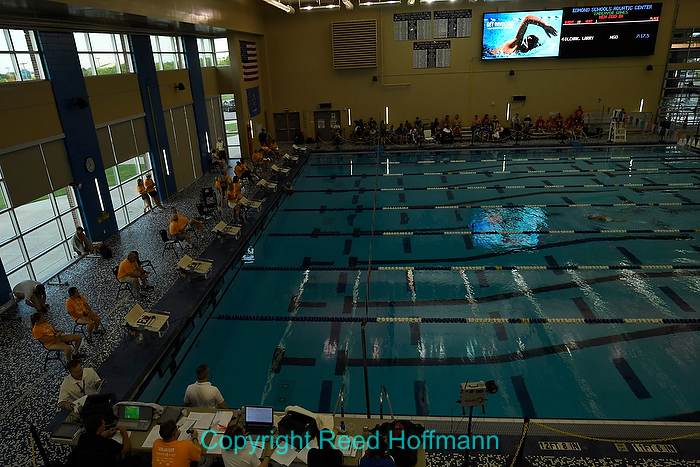
Here’s the pool as seen without the strobes. You can see that the daylight coming in from the left helped with the exposure, but not as much as I would have liked. Nikon D5, Manual exposure, ISO 1000, 1/500 at f/4.5, 0.0 EV, Nikkor AF Zoom 18-35mm f/3.5-4.5G lens at 22mm.
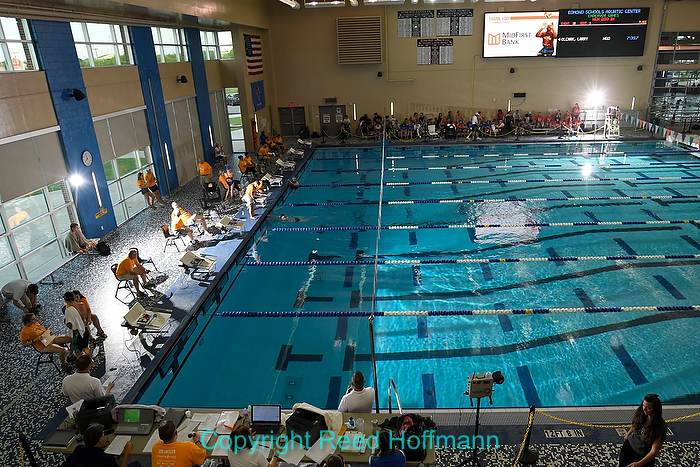
Now you can see where my two strobes were positioned, and the coverage they gave to the center of the pool. Nikon 5, Manual exposure, ISO 1000, 1/500 at f/4.5, 0.0 EV, Nikkor AF Zoom 18-35mm f/3.5-4.5G lens at 22mm.
The one advantage in having lights relatively far from the action was that the area of exposure would be larger. There’s something called the “inverse square law,” and the way it applies to lighting means the closer the light to the subject, the narrower the area of proper exposure. Any closer area will be overexposed, further away will be underexposed. The opposite is true as well. The further the light from the subject, the larger the area of “good” exposure. So there was an advantage, in this case, to having the lights far from the action. The downside, of course, is that less light will get to that action. I’d need work my exposure variables to manage that.
While I shoot at low ISO’s for most of my lighting work (100 or 200), in this case I’d raise my ISO to make up for that distance from the lights. Most of the meet I used 1000 ISO. While I could have gotten away with a lower ISO by raising the power output from the strobes, that would also mean a longer flash duration. That in turn would risk introducing blur, so I settled on the middle ground of lower power for more stop-action. I’d also use a wide aperture, around f/4, for the same reason. Less power from the flashes meant better stopping power with action as well as faster recycling time.
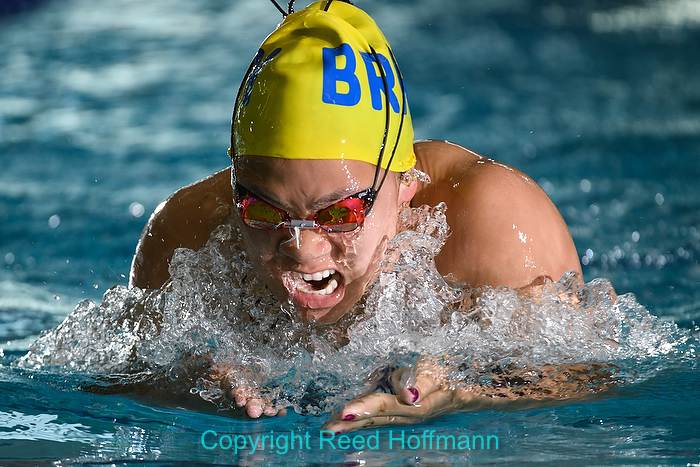
This is exactly what I was looking to get. Notice the lighting is coming from the front right and rear left. Classic cross-lighting. And high shutter speed combined with short flash duration freezes the water and action. Nikon D5, Manual exposure, ISO 1000, 1/500 at f/4.5, 0.0 EV, Nikkor VR Zoom 200-400mm f/4G IF-ED lens at 400mm.
Most cameras have a maximum flash sync speed of 1/250 second. However, some flash units have the ability to “pulse” light, meaning you’re able to shoot at higher shutter speeds. Since the Flashpoints allow that (“high-speed sync”), I set my shutter speed for 1/500.
That combination of light, ISO, aperture and shutter speed worked well for the center section of the pool. My Flashpoint units are Manual, not TTL, so I couldn’t depend on them to adjust exposure for me. If I needed to shoot a swimmer closer or further from the lights, I would simply raise or lower my ISO or adjust my aperture.
Finally, the light from those flashes is in the daylight range, so I set my camera’s white balance to daylight. While the lighting at the pool wasn’t daylight, the strobes would overpower any possible colorcast from the available light. And, just to be safe, I shot in RAW format (NEF for Nikon). That took care of the technical side of the shoot. Now I just needed to make some good pictures!
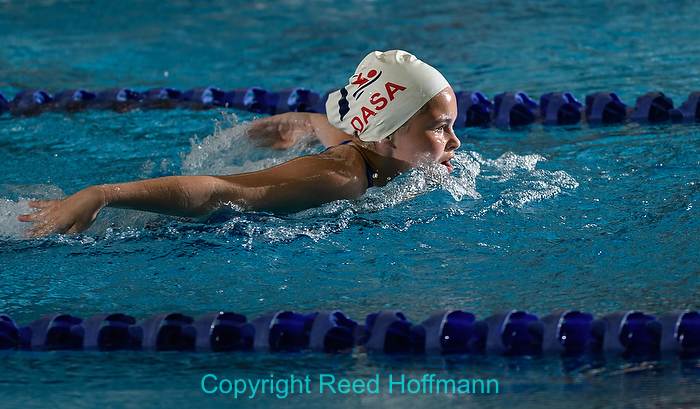
The Flashpoint radio control allowed me to adjust the power of the strobes at any time. For this photo I dialed more power up on the flash in front of the swimmer. Nikon D500, Manual exposure, ISO 1000, 1/500 at f/4.5, 0.0 EV, Nikkor VR Zoom 200-400mm f/4G IF-ED lens at 300mm.
As I mentioned at the beginning, one big challenge photographing swimming is seeing faces. In sprints, the swimmer might only bring their head up to breathe once, twice or not at all. For the crawl, you want to shoot as the arm is arcing over the head, which means actually shooting before you see that happen. Action photography is usually about anticipation. If you see the moment, then it’s probably gone by the time you press the shutter. And, working with strobes, I couldn’t just blaze away with a high frame rate. After each shot I needed to wait a couple of seconds to give the flashes time to recycle. What that meant is that I shot fewer pictures. In normal sports photography, over a three-hour event I can easily shoot a thousand frames. In this case, though, only about two-hundred.
Was it worth it? Absolutely. The contrast, color and quality were much better than I could get with available light. Yes, it was more work to set up, and cut down on the number of photos I could shoot. But bottom line, the pictures came out great, DSUSA was very happy with the results and I had fun doing it. Really, what more could I ask for?
(If you like this story, please share it with your friends and let them know about the links on photography I post on my business Facebook page. I’m also on Instagram and Twitter, @reedhoffmann)

